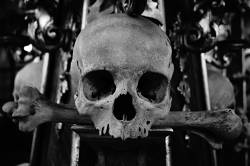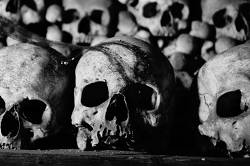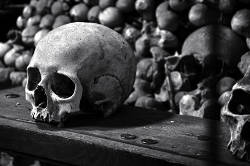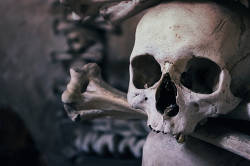Kostnice v Sedlci
Sedletz-Beinhaus
Useful Information

| Location: | Sedlec, near Kutná Hora. Tickets: Ticket office, Zámecká 279, Sedlec. (49.961734, 15.288032) |
| Open: |
MAR daily 9-17. APR to SEP daily 9-18. OCT daily 9-17. NOV to FEB daily 9-16. [2022] |
| Fee: |
Adults CZK 160, Children (6-15) CZK 50, Children (0-5) free, Senior (65+) CZK 120, Students (-26) CZK 120, Disabled CZK 50. Families: Adults CZK 75, Children CZK 50. Groups (8+): Adults CZK 75, Children CZK 50. [2022] |
| Classification: |
 Catacomb Catacomb
|
| Light: |
 Incandescent Incandescent
|
| Dimension: | |
| Guided tours: | V=482,627/a [2019] |
| Photography: | not allowed |
| Accessibility: | no |
| Bibliography: | |
| Address: |
Kostnice-Hřbitovní kostel Všech svatých, Zámecká 127, 284 03 Kutná Hora 3, Tel: +420 731 604 760.
E-mail: |
| As far as we know this information was accurate when it was published (see years in brackets), but may have changed since then. Please check rates and details directly with the companies in question if you need more recent info. |
|

History
| 1142 | Cistercian abbey in Sedlec founded by Miroslav of Markvartic. |
| 14th century | church built as a carnery. |
| 1421 | Kutná Hora captured by Hussite troops and Sedlec attacked. |
| 15th century | cemetery reduced, bones transported into the ossuary. |
| 1630 | first description of decoratively arranged bones by chronist Š. E. Kapihorský. |
| 1661-1663 | church repaired and bones rearranged. |
| 1783 | Sedlec monastery abolished by Joseph II. |
| 1870 | bone decorations renewed and extended by František Rint from Česká Skalice. |
Description


The Kostnice v Sedlci (Sedlec Ossuary) is located in the basement of a chapel beneath the Hřbitovní kostel Všech Svatých (Cemetery Church All Saints). It is a part of the former Sedlec Abbey in Sedlec, a suburb of Kutná Hora. The ossuary contains the skeletons of between 40,000 and 70,000 people, the exact number is unknown. The bones are stacked, but also have been artistically arranged to form decorations and furnishings for the chapel. The weird ossuary is among the most visited tourist attractions of the Czech Republic. The number of visitors reached almost half a million in 2019.
The High Gothic charnel-house was built in the late 14th century. It includes an upper chapel and an underground Ossuary. The Cemetery Church was a part of the oldest Cistercian monastery in Bohemia founded in 1142 by Miroslav of Markvartic. According to legend the abbot was sent to Jerusalem by the Czech King around 1278. He brought a handful of soil from Golgotha and scattered it over the Sedlec cemetery. As a result people from all over Europe desired to be buried in Sedlec.
The cemetery was considerably extended during in the 14th century, as a result of several epidemics and some 30,000 bodies were buried here. In 1421 after the capture of Kutná Hora by Hussite troops Sedlec was also attacked. The monastery and the cathedral were plundered and burned to the ground. The cemetery of the Church of All Saints was also devastated. During the Hussite Wars some 10,000 dead were buried in Sedlec.
At the end of the 15th century the cemetery had an area of 35,000 m² and it became necessary to reduce its size considerably. A part of the graveyard was abolished and the graves excavated, remaining bones were were moved into the Ossuary. According to legend a half-blind monk arranged the bones and skulls into pyramids, and after his work got his eyesight back. There are no historic documents how the ossuary got its shape beneath the legend, the first written description of the decoratively arranged bones by chronist Š. E. Kapihorský is from 1630. But he mentioned they were like this since the 16th century. But the church was finally repaired between 1661 and 1663 and the bones rearranged. Another major reconstruction of the monastery began in the Baroque, in the early 18th century. Jan Blažej Santini–Aichel rebuilt the Cathedral of the Assumption and the Church of All Saints with the Ossuary in Baroque Gothic style. It seems he also rearranged the skeletal decorations according to the Baroque piety and principles of the Baroque aesthetics. The bones form liturgical symbols of cups and monstrances in the niches, garlands of bones, and Baroque angelic heads. The pinnacles-shaped candleholders from 1742 symbolize the eternal light.
In 1783 the Sedlec monastery was abolished by Joseph II. The abbey was sold to the Schwarzenberg family from Orlík, and they maintained the buildings. In 1870 the bone decorations were renewed and extended by František Rint from Česká Skalice. He disinfected and bleached the bones with chlorinated lime. The most spectacular changes were a chandelier in the middle of the chapel and a coat of arms of the Schwarzenberg Family. He also created a signature made of bones at the bottom of the staircase.
The site is quite popular and before Corona there were almost half a million visitors per year. Nevertheless, it is a church and the ossuary is actually a graveyard, which was strongly disrespected by the visitors. To cite their website: "We have had more than enough problems with visitors taking photographs. The pursuit of the perfect picture to post on social media reached an extreme, and so photography is now prohibited in the Ossuary." Actually the first reason for prohibiting photography we strongly agree. Also, they now sell the tickets online, and they prefer online tickets. They may still be purchased at the Information Centre at Zámecká 279 Street, but there is no ticket office at the Ossuary. And another change, tickets for the ossuary only are not available anymore. You have to buy a ticket which is valid at the ossuary and the cathedral.
 Search DuckDuckGo for "Kostnice v Sedlci"
Search DuckDuckGo for "Kostnice v Sedlci" Google Earth Placemark
Google Earth Placemark Sedlec Ossuary - Wikipedia (visited: 29-SEP-2020)
Sedlec Ossuary - Wikipedia (visited: 29-SEP-2020) Ossuary Sedlec, official website (visited: 18-OCT-2022)
Ossuary Sedlec, official website (visited: 18-OCT-2022) Sedlec Ossuary "Bone Church" - Atlas Obscura (visited: 18-OCT-2022)
Sedlec Ossuary "Bone Church" - Atlas Obscura (visited: 18-OCT-2022) Index
Index Topics
Topics Hierarchical
Hierarchical Countries
Countries Maps
Maps